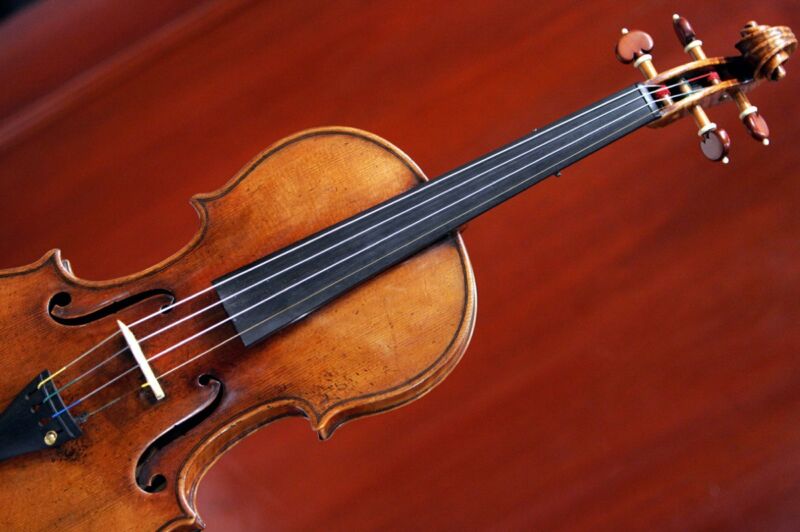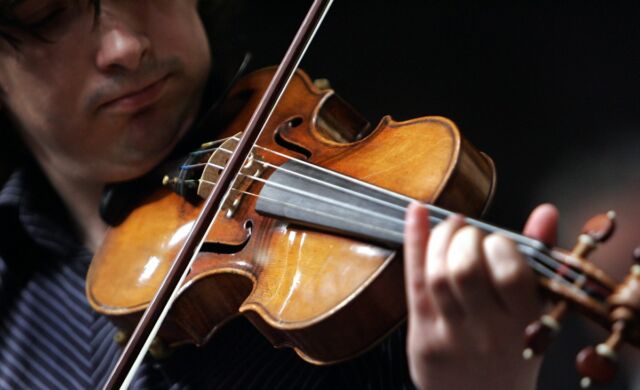Study confirms superior sound of a Stradivari is due to the varnish

Along with Andrea Amati and Andrea Guarneri, Antonio Stradivari dominated the so-called Golden Age of Violins (roughly 1660 to 1750), and the instruments they crafted remain the gold standard today in terms of acoustic quality. World-renowned cellist Yo-Yo Ma has long favored a Stradivarius instrument, as does violinist Joshua Bell. But scientists have been arguing for years about precisely why these instruments have such superior sound. A recent paper published in the journal Angewandte Chemie confirms a theory dating back to 2006: the secret lies in the chemicals used to soak the wood, most notably borax, zinc, copper, alum, and lime water.
I’ve written extensively about this topic in the past. The (perceived) unique sound can’t just be due to the instrument’s geometry, although Stradivari’s geometrical approach did give us the violin’s signature shape. One hypothesis is that Stradivari may have used Alpine spruce that grew during a period of uncommonly cold weather, which caused the annual growth rings to be closer together, making the wood abnormally dense. Another prevailing theory has to do with the varnish: namely, that Stradivari used an ingenious cocktail of honey, egg whites, and gum arabic from sub-Saharan trees—or perhaps salts or other chemicals.
Then again, the difference may be all in our heads. A player’s instrument preference is highly subjective, and there’s some evidence of so-called “psychoacoustics” at play: that is, we’ve become so awed by the name Stradivarius that it influences how we evaluate or respond to the sound of one of Stradivari’s instruments.
In fact, a 2012 double-blind study of 21 experienced violinists found that most of the subjects preferred playing the newer instruments; the Stradivarius ranked last in their preferences. Most of them couldn’t tell the difference between the old and new instruments, with no significant correlation between an instrument’s age and its monetary value. “Rather than searching for the ‘secret’ of Stradivari, future research might best be focused on how violinists evaluate instruments, on which specific playing qualities are most important to them, and on how these qualities relate to measurable attributes of the instruments, whether old or new,” the authors concluded.
The varnish theory dates back to 2006, when Joseph Nagyvary, a professor emeritus of biochemistry at Texas A&M University, made headlines with a paper in Nature claiming that it was the chemicals used to treat the wood—not necessarily the wood itself—that was responsible for the unique sound of a Stradivarius violin. Specifically, it was salts of copper, iron, and chromium, all of which are excellent wood preservers but may also have altered the instruments’ acoustical properties. He based his findings on studies using infrared and nuclear magnetic resonance spectroscopy to study the chemical properties of the backboards of several violins (the backboard is the instrument’s largest resonant component).

In 2007, physicist George Bissinger of East Carolina University used a 3D scanning laser to produce detailed and quantitative measurements of the acoustic properties of several Strad violins—essentially mapping out how they vibrate to produce those heavenly tones. Bissinger hung each of the five violins by elastic bands, then struck the wood of the top plate with a little hammer while recording and measuring the vibrational modes with the scanner.
He specifically wanted to measure the in-plane and out-plane motion: the in-plane motion is the source of much of the sound energy, and this converts into out-plane motion, which produces the rich tonal sounds we associate with fine violins. In addition, he hired a world-class violinist to play each of the violins used in the study for an hour to get the feel of the instruments and then offer subjective ratings for each one. The musician’s subjective analysis was then compared to the objective acoustical data. The resulting measurements were sufficiently detailed to reconstruct the stiffness properties of the wood used to make the Strads, according to Bissinger.
CT scans
In 2008, Berend Stoel from the Leiden University Medical Center in the Netherlands collaborated with a luthier named Terry Borman to take CT scans of several Strads, along with several modern instruments for comparison. The aim was to study the density of the woods used, since differentials in wood density impact vibrational efficiency and thereby the production of sound. Stoel had developed a computer program that noninvasively calculated lung densities in people suffering from emphysema, and he adapted it to study wood densities from CT scans.
There wasn’t much significant difference between the average wood density of the classical and modern violins used in the study. But the density differences between wood grains of early and late-growth wood was significantly smaller in the classical Cremonese violins compared with modern violins. “Our results clearly document basic material property differences between the woods used by the classical Cremonese and contemporary makers,” the authors concluded.
More evidence in favor of Team Varnish came from a 2016 study by researchers at the Swiss Federal Laboratories for Materials Science and Technology (EMPA). They studied how a varnish’s chemical composition, thickness, and degree of penetration into the wood affected the acoustics of the instrument.
As I wrote for Gizmodo in 2016:
They used samples of Norway spruce tone wood cut from the same tree and coated the samples with different kinds of varnish: two of their own making, and two used by German master violin makers. Then they conducted vibration tests of the samples over time, using x-ray tomography to measure the effects.
The researchers found that all the varnishes increased the wood’s dampening ability—that is, how well it absorbs and stops vibrations. That extra damping, compared to unvarnished wood, leads to a warmer, mellower, and aesthetically pleasing sound. The varnishes favored by German luthiers performed slightly better in that regard, and also made for better sound radiation (louder tones).
A 2017 study by Taiwanese researchers compared the maple used by Stradivarius with modern, high-quality maple wood. Their analysis showed evidence of chemical treatments in the form of aluminum, calcium, and copper, among other elements. And thanks to the decomposition over time of a wood component called hemicellulose, the Stradivari and Guarneri instruments used in the study had 25 percent less water than modern instruments. “This is fundamentally important because the less moisture, the more brilliant the sound,” Nagyvary told The New York Times.

This latest study analyzes trace chemicals preserved in the maple wood used to make the soundboards of Stradivari and Guarneri instruments. The research involved a rare collection of Cremonese wood samples of spruce and maple used by Stradivari, Guarneri, and Amati, and the results were then compared to modern spruce and maple tonewoods, as well as woods from antique Chinese zithers and less exceptional old European violins.
They found traces of borax and several metal sulfates in the wood samples dating between 1600 to 1750. As David Bressan explained over at Forbes:
Borax, also known as sodium-borate, occurs naturally in evaporite deposits produced by the repeated evaporation of seasonal lakes. Borax is still used today in various household laundry and cleaning products, and in the past was used also as an insecticide and fungicide, killing pests. Copper and zinc sulfates, often associated with copper ore, likely served the same purpose. Alum, an evaporite mineral containing sulfur, aluminum, potassium and sodium, was added to the mix to form a weak acidic environment in the wood, preventing mold growth. Halite, common table salt, was added as moisture control, keeping the wood too dry for microbes and fungi, and at the same time preventing the deformation of the instrument caused by humidity fluctuations.
This is welcome news to Nagyvary, who co-authored this latest paper. “This new study reveals that Stradivari and Guarneri had their own individual proprietary method of wood processing, to which they could have attributed a considerable significance,” he told Texas A&M Today. “They could have come to realize that the special salts they used for impregnation of the wood also imparted to it some beneficial mechanical strength and acoustical advantages. These methods were kept secret. There were no patents in those times. How the wood was manipulated with chemicals was impossible to guess by the visual inspection of the finished product.”
Nagyvary still thinks more research is needed to shed further light on the connection between the chemicals used to treat the wood and the sound quality of the finished instruments. “First, one needs several dozens of samples from not only Stradivari and Guarneri, but also from other makers of the Golden Period (1660-1750) of Cremona, Italy,” he said. “There will have to be better cooperation between the master restorers of antique musical instruments, the best makers of our time, and the scientists who are performing the experiments often pro bono in their free time.”
DOI: Angewandte Chemie, 2021. 10.1002/anie.202105252 (About DOIs).
https://arstechnica.com/?p=1792679